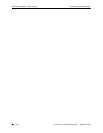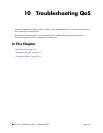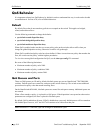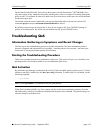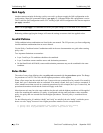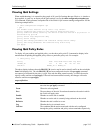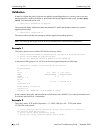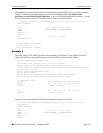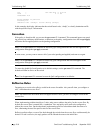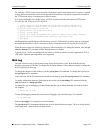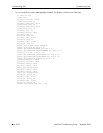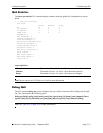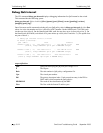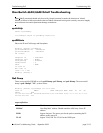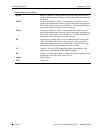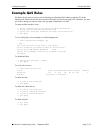
Troubleshooting QoS Troubleshooting QoS
page 10-8 OmniSwitch Troubleshooting Guide September 2005
*IP : 192.168.10.0 -> 0.0.0.0
*UDP : 0 -> 69
*TOS/DSCP: 0/0
Using pending l3 policies
Classify L3:
*Matches rule 'oktftp': action oktftp (accept)
In this example, the display indicates that the switch found a rule, “oktftp”, to classify destination traffic
with the specified Layer 3 information.
Correction
If the policy is found invalid, you can use the qos revert CLI command. This command ignores any pend-
ing policies (any additions, modifications, or deletions to the policy configuration since the last qos apply)
and writes the last applied policies to the pending configuration.
Note. Use the qos revert CLI command to delete any QoS configuration that has not been applied to the
configuration through the qos apply command.
In some cases, you may want to remove all of your rules (pending and applied) and start over again.
Note. Use the qos flush CLI command to deletes any QoS configuration that has been applied to the
configuration through the qos apply command.
To return the global QoS configuration to its default settings, use the qos reset CLI command. The
defaults will then be active on the switch.
Note. Use the qos reset CLI command to reset the QoS configuration to its defaults.
Reflexive Rules
Forgetting to set a rule to be reflexive could be the cause of troubles. Ask yourself when you configure a
rule, “what about the reverse flow?”
Note. The OmniSwitch 6624/6648 does not support reflexive rules; you have to configure a rule for the
reverse flow.
When implementing unidirectional layer 3 rules, make sure to address the policy for the reverse flow. By
default, the reverse flow is treated like a “standalone” flow and policy rules need to be configured to
address the reverse flow. On the other hand, implementing reflexive rules address both directions of a
flow, eliminating the need for specific rules for the reverse flow.
Reflexive policies allow a reverse flow back through the switch when the reverse flow would normally be
denied. If a rule is reflexive, the reply packets will be filtered the same as the initial flow.



